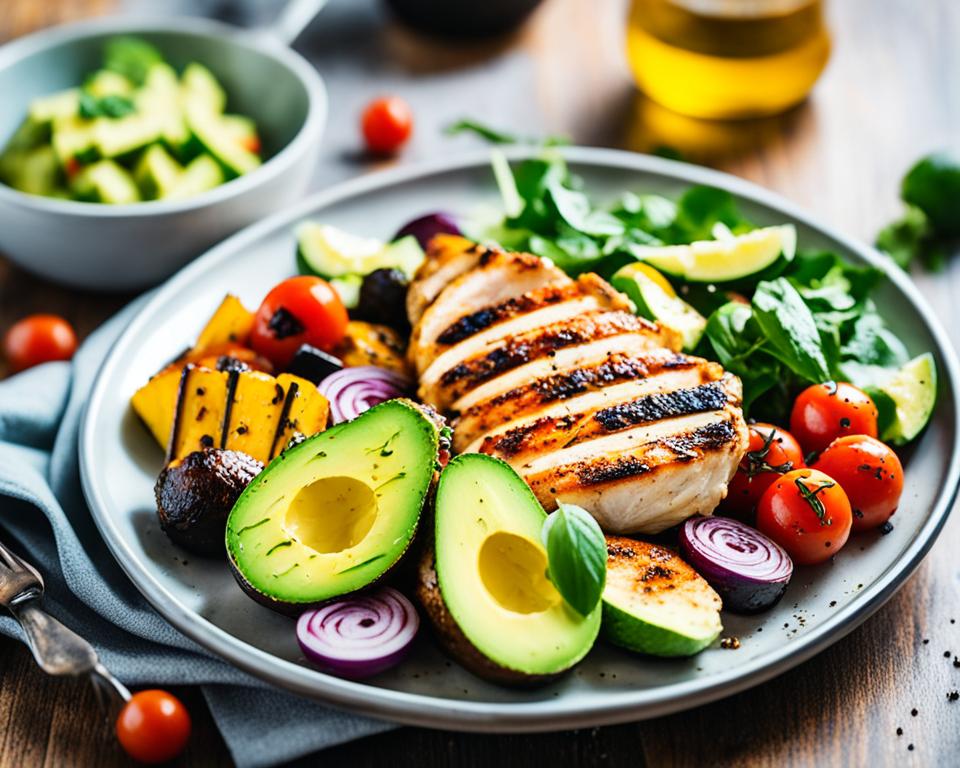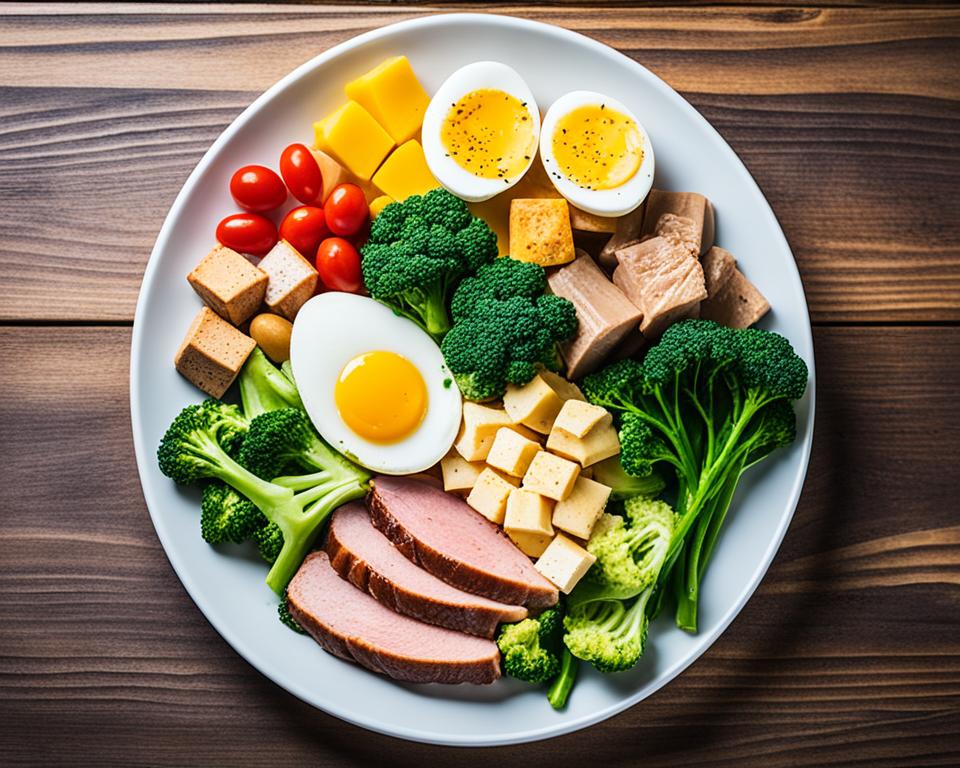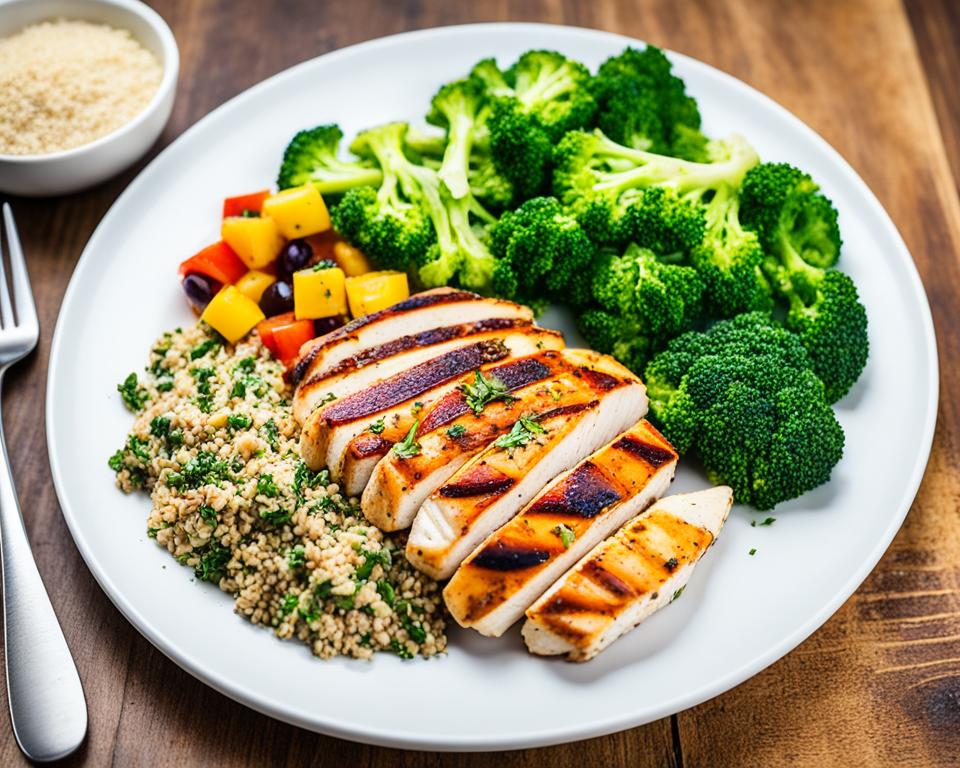Meal prepping is a time-saving solution for busy individuals who want to eat healthy. In this article, we will explore 23 keto-friendly meal prep recipes that are low-carb and perfect for weight loss. These recipes have less than 15g of net carbs, with most being under 10g. Keto meal prep involves making meals ahead of time for the week, typically including grains or carbs, protein, and vegetables. Investing in glass meal prep containers is recommended for storing your prepared meals.
Key Takeaways:
- Keto meal prep is a convenient way to eat healthy and save time.
- There are 23 keto-friendly meal prep recipes that are low-carb and perfect for weight loss.
- Investing in glass meal prep containers is recommended for storing your prepared meals.
- Most of the keto meal prep recipes have less than 15g of net carbs, with many being under 10g.
- Meal prepping involves making meals ahead of time for the week, including grains or carbs, protein, and vegetables.
What Is Meal Prepping?
Meal prepping is the process of making meals ahead of time to be consumed throughout the week. It is a popular strategy for individuals following a keto diet, allowing them to stay on track with their nutritional goals. By preparing meals in advance, you can ensure that you have healthy and delicious options readily available, saving you time and effort during busy weekdays.
Meal prepping often involves preparing dishes such as stir-fries, salads, and grain-based meals. These recipes are versatile and can be customized to suit individual preferences and dietary restrictions. Whether you prefer a hearty salad packed with nutritious ingredients or a flavorful stir-fry with lean protein and vegetables, meal prepping allows you to enjoy a variety of meals without compromising your health goals.
The key to successful meal prepping is layering the ingredients strategically to prevent them from becoming soggy. For example, when preparing a salad, consider storing the dressing separately to maintain the crispness of the greens. When packing grain-based meals, layering the ingredients with a barrier, such as a leafy green or a sauce, can help maintain their texture and flavor.
Meal prepping is an effective way to ensure that you eat healthy and stay on track with your keto journey. By taking the time to plan and prepare your meals in advance, you can avoid impulsive food choices and make mindful decisions that support your well-being.
In addition to the health benefits, meal prepping also offers the convenience of having ready-to-eat meals whenever you need them. Whether you’re a busy professional, a student, or a parent juggling multiple responsibilities, having meals readily available can save you time and energy during hectic weekdays.
Meal prepping is an excellent tool for achieving and maintaining a balanced keto diet. It allows you to take control of your nutrition, experiment with new recipes, and ensure that you have delicious options to enjoy throughout the week. With proper planning and organization, meal prepping can simplify your life and contribute to your overall well-being.
How to Keto Meal Prep
Keto meal prep follows the same principles as regular meal prepping. It is a strategic approach to preparing and organizing meals to align with your ketogenic diet. Planning and preparation are key for successful keto meal prep.
Gather Your Ingredients
In order to keto meal prep effectively, it’s important to plan ahead and have all the necessary ingredients on hand. Make a comprehensive list of keto-friendly ingredients that you’ll need for your chosen recipes.
Choose Low Carb Recipes
When selecting recipes for your keto meal prep, opt for low carb options that adhere to your dietary requirements. Look for recipes with a low net carb per serving to help you stay within your desired macronutrient range.
Pro Tip: Consider using keto recipe websites, cookbooks, or meal planning apps to discover a wide range of delicious low carb recipes for your keto meal prep.
Invest in Glass Meal Prep Containers
It is recommended to invest in high-quality glass meal prep containers for storing your keto meals. Glass containers are durable, easy to clean, and safe for reheating in the microwave or oven. They also help to maintain the freshness and flavor of your prepared meals.
| Benefits of Glass Meal Prep Containers |
|---|
| 1. Durable and long-lasting |
| 2. Easy to clean |
| 3. Microwave and oven safe |
| 4. Preserve the freshness of meals |
Table: Benefits of Glass Meal Prep Containers
Plan for 4-5 Days in Advance
Keto meal prep is all about efficiency, so plan your meals in advance for a period of 4 to 5 days. This way, you’ll have your meals ready and available, reducing the need for last-minute decisions or unhealthy food choices.
Include a Variety of Recipes
Aim to include a variety of recipes in your keto meal prep to avoid monotony and ensure you get a wide range of nutrients. Plan meals that include grains or carbs, protein, healthy fats, and vegetables to create a well-rounded and satisfying menu.
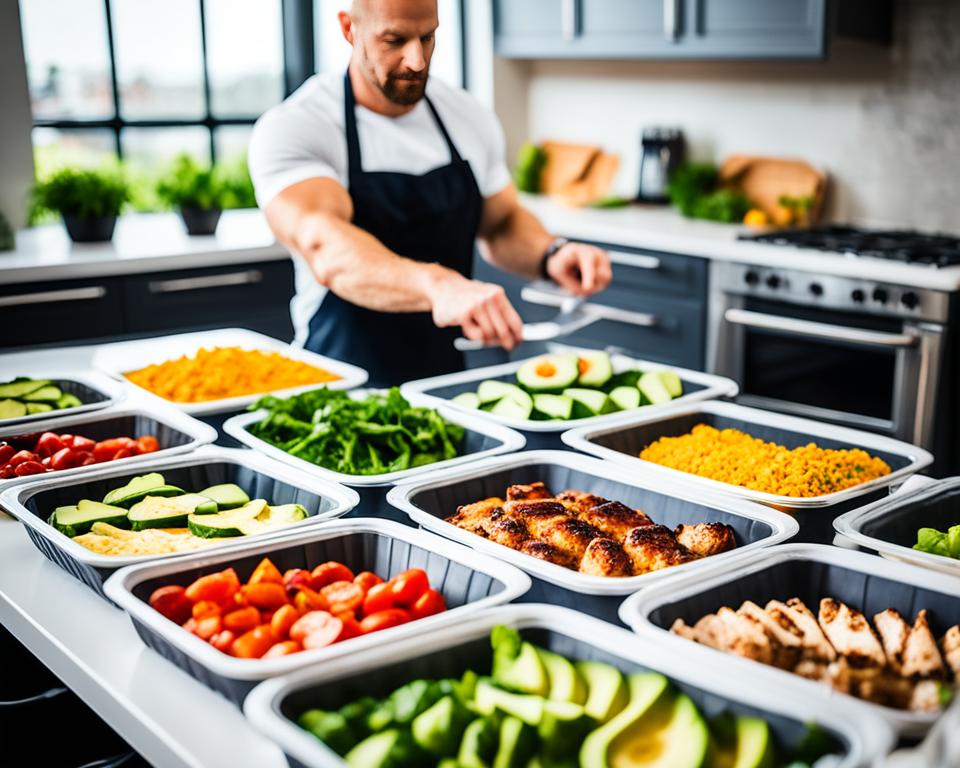
Which Version of Keto Should You Follow?
The version of keto you choose to follow depends on your individual goals and needs. There are several variations of the ketogenic diet, each designed to cater to specific outcomes. Understanding the different versions can help you make an informed decision about which one is right for you.
Standard Ketogenic Diet (SKD)
The standard ketogenic diet (SKD) is the most commonly followed version and is suitable for weight loss and overall health improvement. This approach emphasizes high fat, moderate protein, and low carbohydrate intake.
On the SKD, the primary goal is to achieve a state of ketosis, where your body uses fat as its main source of fuel instead of glucose. By limiting carbs to 20-50 grams per day, your body starts producing ketones, which can lead to weight loss, increased mental clarity, and improved energy levels.
Targeted Ketogenic Diet (TKD)
The targeted ketogenic diet (TKD) is ideal for individuals who engage in high-intensity workouts or sports activities and need a boost in performance. This version allows you to consume a small amount of carbohydrates 30 minutes to an hour before your workout to provide an energy source for intense physical exertion.
By strategically timing carbohydrate intake around exercise, TKD ensures that you have enough glycogen stores for optimal performance while still maintaining ketosis for the rest of the day.
Cyclical Ketogenic Diet (CKD)
If you’re a bodybuilder or an athlete with a high-intensity training schedule, the cyclical ketogenic diet (CKD) may be suitable for you. This approach involves cycling between periods of strict ketosis and higher carbohydrate consumption.
Typically, CKD consists of five days of strict keto followed by two days of higher carbohydrate intake. This “carb-up” phase replenishes glycogen stores to support intense training while still allowing the body to return to ketosis during the strict keto phase.
High-Protein Ketogenic Diet (HPKD)
The high-protein ketogenic diet (HPKD) is a variation of the standard ketogenic diet with an emphasis on increased protein intake. This version is often recommended for individuals who lift weights frequently and want to maintain or build muscle mass while losing weight.
With the HPKD, you’ll consume a higher ratio of protein to fat compared to the standard ketogenic diet. This approach provides the necessary amino acids for muscle repair and growth while still keeping carb intake low enough to induce and maintain ketosis.
Choosing the right version of keto is crucial to aligning your diet with your goals. Whether you’re aiming for weight loss, improved mental clarity, enhanced exercise performance, or muscle development, selecting the most appropriate version will optimize your results.
| Version | Goal | Main Principles |
|---|---|---|
| Standard Ketogenic Diet (SKD) | Weight loss, overall health improvement | High fat, moderate protein, low carbohydrate intake |
| Targeted Ketogenic Diet (TKD) | Improved exercise performance | Small carb intake before workouts, strict keto rest of the time |
| Cyclical Ketogenic Diet (CKD) | Bodybuilding, high-intensity training | Cycling between strict keto and higher carb days |
| High-Protein Ketogenic Diet (HPKD) | Muscle maintenance/building while losing weight | Increased protein intake, moderate-high fat, low carb |
Remember, it’s important to consult with a healthcare professional or registered dietitian to determine which version of the ketogenic diet is most suitable for your specific needs and to ensure you’re meeting all your nutritional requirements.
Calculate Your Macronutrients
When following a keto meal plan, it is essential to calculate your macronutrients accurately. Macronutrients, also known as macros, are the major nutrients that provide energy to your body. They include fat, protein, and carbs.
The typical ratios for a ketogenic diet are:
- Fat: 70-80% of calories
- Protein: 20-25% of calories
- Carbs: 5-10% of calories
These ratios are designed to shift your body into a state of ketosis, where it burns fat for fuel instead of carbohydrates.
Determining the exact grams of fat, protein, and carbs you need each day is important for effective meal planning. To simplify this process, you can use a keto macro calculator. This tool takes into account your individual body composition and lifestyle to provide personalized macronutrient recommendations.
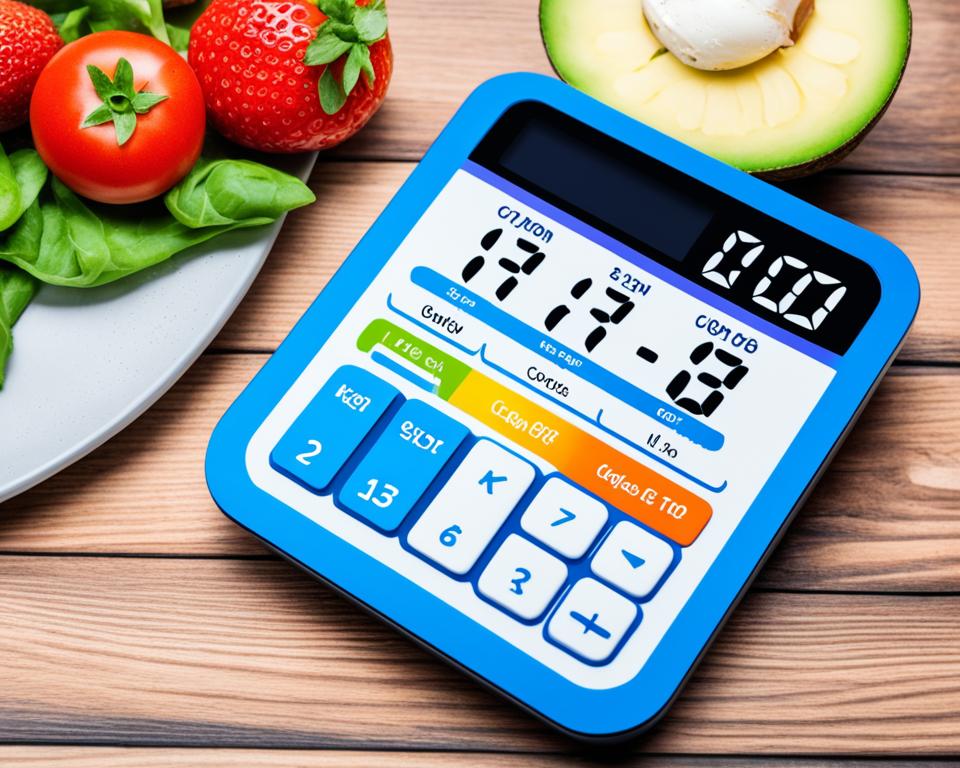
Calculating your macronutrients allows you to tailor your keto meal plan to your specific needs. It ensures that you are consuming the right balance of nutrients to achieve and maintain ketosis.
By following the recommended macronutrient ratios and using a keto macro calculator, you can have a clear understanding of how much fat, protein, and carbs you should include in your meals. This knowledge empowers you to make informed food choices and optimize your keto journey.
Plan Your Meals
Planning your meals is essential for successful keto meal prep. By creating a detailed keto meal plan, you can ensure that you have delicious and nutritious meals ready for the entire week. Taking the time to plan ahead will save you valuable time and effort in the long run. Here’s how to effectively plan your keto meals:
- Set aside time: Dedicate a specific time each week to sit down and plan your meals for the next seven days. This could be on a Sunday afternoon or any other day that works best for you.
- Consider your needs: Take into account the number of people you are cooking for, any dietary restrictions, and whether you want to have leftovers for easy grab-and-go meals.
- Structure your days: Decide how you want to structure each day. For example, if you prefer to have breakfast, plan accordingly. If you choose to fast until lunch, factor that into your meal plan.
- Use keto-friendly recipes: Incorporate a variety of keto-friendly recipes into your meal plan. Look for recipes that are low in carbohydrates and high in healthy fats. This will ensure that you stay within your macros and enjoy tasty meals.
- Create a grocery list: After finalizing your meal plan, create a comprehensive grocery list. This will ensure that you have all the necessary ingredients for your meals and eliminate any last-minute runs to the store.
- Utilize resources: To make the planning process easier, consider downloading a keto meal plan eBook and a grocery list template. These resources can provide additional recipe ideas and streamline your planning process.
Planning your meals in advance allows you to stay on track with your keto diet and make healthier choices. It also helps you save time and reduce unnecessary stress during the week. With a well-thought-out meal plan and grocery list in hand, you’ll be well-prepared to tackle your keto meal prep with ease.
Start Cooking
With your meal plan and ingredients ready, it’s time to start cooking. Whether you prefer to dedicate one day to prep and cook all your meals or spread it out over a few days, the choice is yours. The key is to follow the recipes and instructions provided in the keto recipe eBook to ensure that your meals turn out delicious and perfectly aligned with your keto meal prep goals.
To make the cooking process easier and more efficient, consider utilizing kitchen tools such as a slow cooker or Instant Pot. These appliances can save you time and effort, allowing you to focus on other tasks while your meals are being prepared.
“Cooking is like love. It should be entered into with abandon or not at all.” – Harriet Van Horne
Exploring various keto recipes and experimenting with different flavors can make the cooking experience enjoyable and keep your meals interesting. Remember to pay attention to portion sizes and ensure that you are meeting your macronutrient targets with each meal you prepare.
Keto Meal Cooking Tips:
- Follow the instructions provided in the keto recipe eBook
- Utilize kitchen tools like slow cookers or Instant Pots
- Experiment with different keto recipes and flavors
- Pay attention to portion sizes and macronutrient ratios
Example Keto Meal Prep Schedule:
| Day | Preparation | Cooking |
|---|---|---|
| Monday | Plan meals, make grocery list | Prepare slow cooker chicken |
| Tuesday | Chop vegetables | Cook cauliflower rice |
| Wednesday | Prepare salad ingredients | Cook salmon and asparagus |
| Thursday | Portion snacks | Bake keto-friendly cookies |
| Friday | N/A | Enjoy your prepped meals! |
The 7-Day Keto Meal Plan
Below is a 7-day keto meal plan to help you get started on your keto journey. Each day includes keto-friendly breakfast, lunch, dinner, snacks, and desserts. The meals are designed to meet the recommended macronutrient ratios for a ketogenic diet. Feel free to mix and match the meals based on your tastes and preferences. The recipes for each meal can be found in the provided keto recipe eBook.
Day 1
| Meal | Description |
|---|---|
| Breakfast | Avocado and Bacon Egg Cups |
| Lunch | Keto Caesar Salad with Grilled Chicken |
| Dinner | Baked Salmon with Asparagus |
| Snacks | Keto Fat Bombs |
| Dessert | Keto Chocolate Mug Cake |
Day 2
| Meal | Description |
|---|---|
| Breakfast | Spinach and Mushroom Omelette |
| Lunch | Keto Cobb Salad |
| Dinner | Zucchini Noodles with Meatballs |
| Snacks | Cheese Crisps |
| Dessert | Vanilla Chia Pudding |
Day 3
| Meal | Description |
|---|---|
| Breakfast | Bulletproof Coffee |
| Lunch | Keto Chicken and Broccoli Stir-fry |
| Dinner | Grilled Steak with Cauliflower Mash |
| Snacks | Almond Butter Fat Bombs |
| Dessert | Coconut Flour Cookies |
Day 4
| Meal | Description |
|---|---|
| Breakfast | Keto Pancakes with Sugar-Free Syrup |
| Lunch | Keto Chicken Salad Lettuce Wraps |
| Dinner | Mozzarella Stuffed Meatballs with Marinara Sauce |
| Snacks | Hard-Boiled Eggs |
| Dessert | Keto Cheesecake Bites |
Day 5
| Meal | Description |
|---|---|
| Breakfast | Keto Breakfast Burrito |
| Lunch | Keto Taco Salad |
| Dinner | Pork Chops with Roasted Brussels Sprouts |
| Snacks | Keto Guacamole with Zucchini Chips |
| Dessert | Keto Peanut Butter Cups |
Day 6
| Meal | Description |
|---|---|
| Breakfast | Low Carb Greek Yogurt with Berries |
| Lunch | Keto Egg Salad |
| Dinner | Cajun Shrimp with Cauliflower Rice |
| Snacks | Keto Trail Mix |
| Dessert | Keto Lemon Bars |
Day 7
| Meal | Description |
|---|---|
| Breakfast | Keto Green Smoothie |
| Lunch | Keto Caprese Salad |
| Dinner | Keto Zucchini Lasagna |
| Snacks | Baked Cheese Crisps |
| Dessert | Keto Strawberry Ice Cream |
Supplements for the Keto Meal Plan
While not necessary, some individuals may choose to supplement their keto meal plan with additional nutrients. There are various supplements available that can support a ketogenic diet, such as MCT oil, electrolytes, and exogenous ketones. It is important to consult with a healthcare professional or registered dietitian before adding any supplements to your diet. They can help determine if supplementation is necessary and guide you on the appropriate dosage.
Supplements can be a helpful addition to your keto meal plan, providing additional support for your body and helping you achieve your health goals. However, it is essential to approach supplementation with caution and consult with a healthcare professional to ensure it is suitable for your individual needs.
1. MCT Oil
MCT oil, or medium-chain triglyceride oil, is a popular supplement among individuals following a ketogenic diet. It is derived from coconut oil and is rich in medium-chain fatty acids that can be easily converted into ketones by the body. Adding MCT oil to your meals or beverages can help increase your fat intake and promote ketosis.
2. Electrolytes
When following a keto diet, your body may experience a shift in electrolyte balance, leading to symptoms like fatigue, muscle cramps, and headaches. Supplementing with electrolytes, such as sodium, potassium, and magnesium, can help replenish these essential minerals and alleviate these symptoms. You can find electrolyte supplements in powder or tablet form.
3. Exogenous Ketones
Exogenous ketones are supplements that provide your body with additional ketones from an external source. They can help enhance ketosis, increase energy levels, and support mental clarity. Exogenous ketones are available in various forms, including powders, liquids, and snacks.
Conclusion
Keto meal prep is a practical and effective strategy for weight loss and maintaining a healthy lifestyle. By prepping your meals ahead of time, you can ensure that you are making healthy food choices and save time during the week. With the variety of keto-friendly recipes available, you can enjoy delicious meals while achieving your weight loss goals.
To make the most of your keto meal prep, it’s important to plan your meals in advance. Take the time to calculate your macronutrients and ensure you’re getting the right balance of fat, protein, and carbs. This will help you stay in ketosis and maximize your weight loss efforts.
Investing in quality meal prep containers is also key. Look for containers that are durable, leak-proof, and easy to clean. Glass containers are a great option as they are microwave and dishwasher safe. With the right containers, you can portion out your meals and have them ready to grab and go throughout the week.
So, whether you’re looking to shed a few pounds or simply live a healthier lifestyle, keto meal prep is a time-saving and effective solution. Start prepping your meals today and enjoy the benefits of weight loss, improved health, and the convenience of having delicious meals ready to enjoy at any time.
FAQ
What is meal prepping?
Meal prepping is the process of making meals ahead of time to be consumed throughout the week. It involves preparing dishes like stir-fries, salads, and other grain-based meals to ensure you have healthy and convenient options readily available.
How do I keto meal prep?
Keto meal prep follows the same principles as regular meal prepping. You plan ahead, choose low carb recipes with a low net carb per serving, and invest in glass meal prep containers for easy storage. Aim for a variety of recipes that include grains or carbs, protein, and vegetables.
Which version of keto should I follow?
The version of keto you should follow depends on your individual goals. The standard ketogenic diet (SKD) is recommended for weight loss and overall health. The targeted ketogenic diet (TKD) is ideal for improving workout performance. The cyclical ketogenic diet (CKD) is suitable for bodybuilders or athletes with a high-intensity training schedule. The high-protein ketogenic diet (HPKD) is recommended for individuals who lift weights frequently.
How do I calculate my macronutrients for a keto diet?
Calculating your macronutrients is crucial for following a keto meal plan. The typical ratios for a ketogenic diet are 70-80% of calories from fat, 20-25% from protein, and 5-10% from carbs. Use a keto macro calculator to determine the grams of fat, protein, and carbs you need each day based on your body composition and lifestyle.
How do I plan my meals for keto meal prep?
Planning your meals is essential for successful keto meal prep. Set aside time each week to create a meal plan for the next seven days. Consider the number of people you are cooking for, whether you want leftovers, and how you want to structure each day. Use keto-friendly recipes and a grocery list to ensure you have all the necessary ingredients.
How do I start cooking for keto meal prep?
With your meal plan and ingredients ready, it’s time to start cooking. Depending on your schedule and preferences, you can choose to prep and cook most of your meals in one day or spread it out over a few days. Follow the recipes and instructions provided in the keto recipe eBook to prepare your meals. Consider using kitchen tools like a slow cooker or Instant Pot to make the process easier and more efficient.
Can I get a 7-day keto meal plan?
Yes, below is a 7-day keto meal plan to help you get started on your keto journey. Each day includes keto-friendly breakfast, lunch, dinner, snacks, and desserts. The meals are designed to meet the recommended macronutrient ratios for a ketogenic diet. Feel free to mix and match the meals based on your tastes and preferences. The recipes for each meal can be found in the provided keto recipe eBook.
Should I take supplements for my keto meal plan?
While not necessary, some individuals may choose to supplement their keto meal plan with additional nutrients. There are various supplements available that can support a ketogenic diet, such as MCT oil, electrolytes, and exogenous ketones. Consult with a healthcare professional or registered dietitian before adding any supplements to your diet to determine if they are necessary and the appropriate dosage.
Is keto meal prep beneficial for weight loss?
Yes, keto meal prep is a practical and effective strategy for weight loss. By prepping your meals ahead of time, you can ensure that you are making healthy food choices and save time during the week. With the variety of keto-friendly recipes available, you can enjoy delicious meals while achieving your weight loss goals.


